Anthologies. We know them. We love them. We’re THANKFUL for them. That is why, in this November edition of “Arrivals and Departures,” I will look at the surplus of many-artist compendiums that I have recently got acquainted with. Just like last year’s anthology round-up, these reviews will be broken down into categories: MVP of the issue, biggest surprise, and my bottom-line final thoughts.

Nib Rot #1, edited by RIMKI, Ryan Edge, and Scott Witmer
A new one out of the great state of Illinois. Nib Rot thankfully doesn’t bother with a hamfisted motif, which is a lesson all editors could learn from. The overarching theme for every anthology should be “Good Comics” and that’s it, that’s all.
MVP: A certain Mr. Paul Nudd — who I first wrote about back in 2014 for my bygone blog — anchors down the middle of this issue with four pages of grotesqueries. His style perhaps is a little out of place in a book that feels slightly Americana-tinged, but I’m a fan nonetheless. Nudd’s work is like if the Chicago Imagists decided their chosen medium was going to be cat puke and hirsute scrotums. I prefer his paintings with all their secreting colors, but these ink drawings get the job done too.
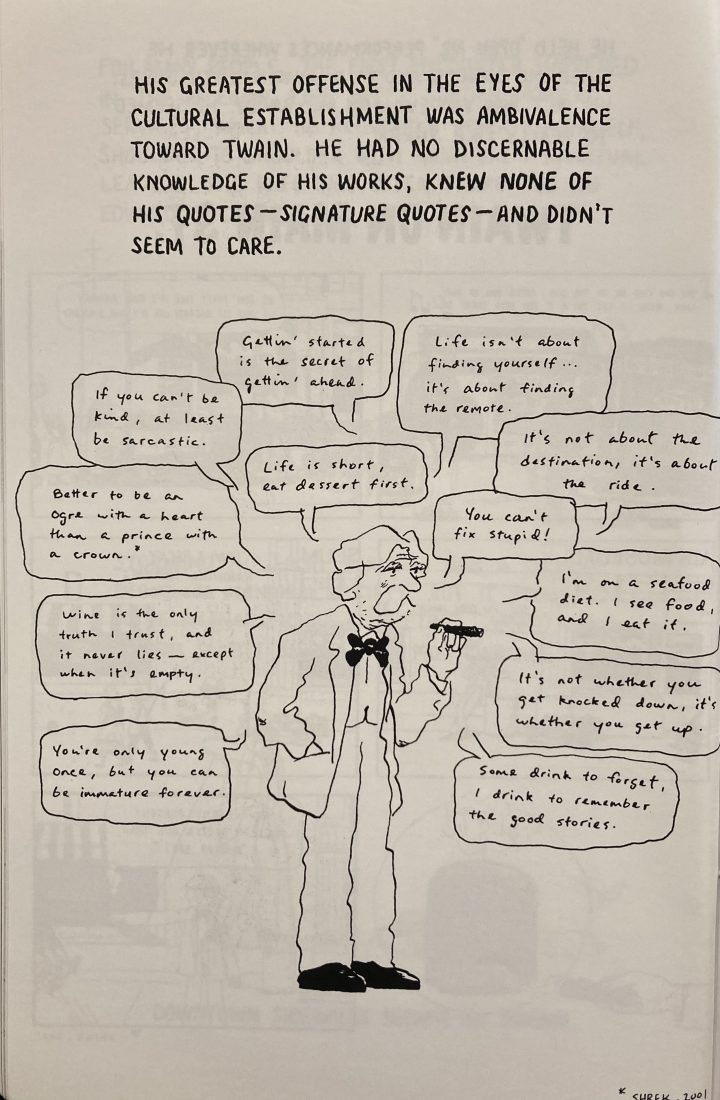
BIGGEST SURPRISE: My friend Brian and I used to go to a Civil War reenactment every year. One time, on a blazing hot summer day, we got primo seating for the surrender at the church that was pretending to be the Appomattox Court House. The elderly man sitting next to us had a hearing aid that was ringing so loud we couldn’t hear any of the actors and it felt like steam was rising off the sunken wooden floors. We had to crawl over the top of dozens of pews, bottles of sarsaparilla in hand, to make our daring, pesky escape. I love history! This is all to say that the main course and best story in Nib Rot is called “Twains” by a cartoonist I was unfamiliar with named Ryan Edge. And it’s about actors portraying Mark Twain in Hannibal, Missouri. When a self-destructive “Dark Twain” saunters into town it sets the establishment raconteurs into a tizzy. He’s not playing by the rules. He’s not paying his dues. He’s definitely not taking it rung by rung up the ladder like the other local impressionists. Pages here have scant panels and Edge lets the story breathe, sometimes telling the joke with his writing and other times with his thin-line scrawly cartooning and Twain caricatures. For the white-suited wanderer, shrewdness loses the battle to resentment (and eventually victimhood) when the Twain tycoons and officials push this interloper out and we’re left wondering if this is all anti-social behavior writ large or if this is an industry that needs a genuine disruptor. Edge asks: Who is and isn’t allowed to participate in this historical-based attention economy? Who impersonates the impersonators?
BOTTOM LINE: Along with the contributions mentioned above, Nib Rot also includes a story of mistaken-identity-turned-murder-mystery and some cross-hatched drawings of old industrial mills. I was quite taken with the whole endeavor.
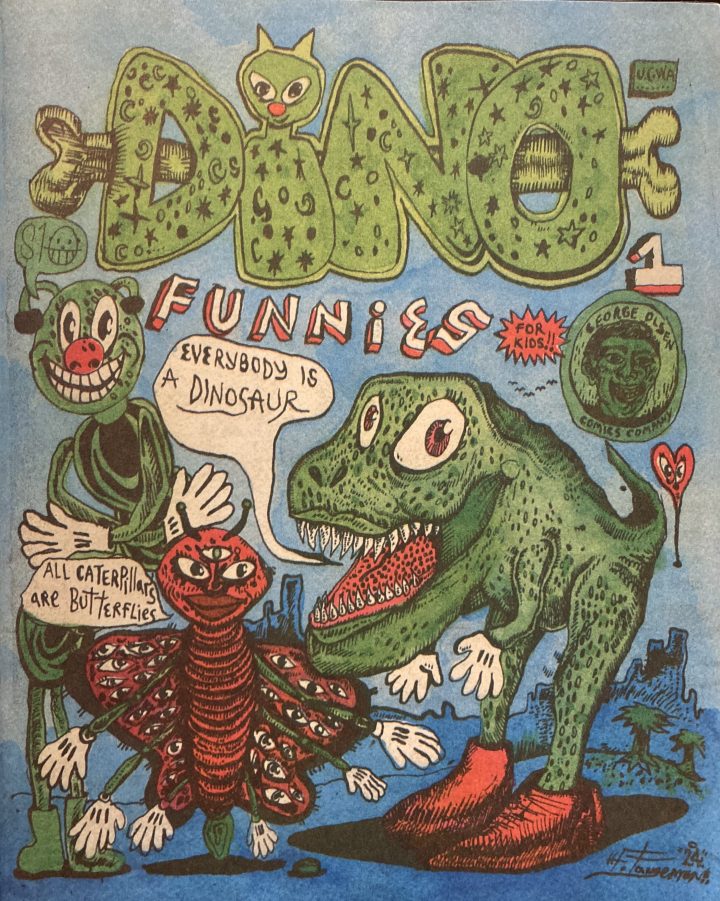
Dino Funnies #1, edited by George Olsen
Dino is a squat newsprint Clamp Comics offshoot anthology designated for young readers. It says “for kids!!” right on the front cover. It’s also full of some of the world’s best cartoonists who you can tell have no children of their own and don’t seem all that comfortable working within the set parameters.
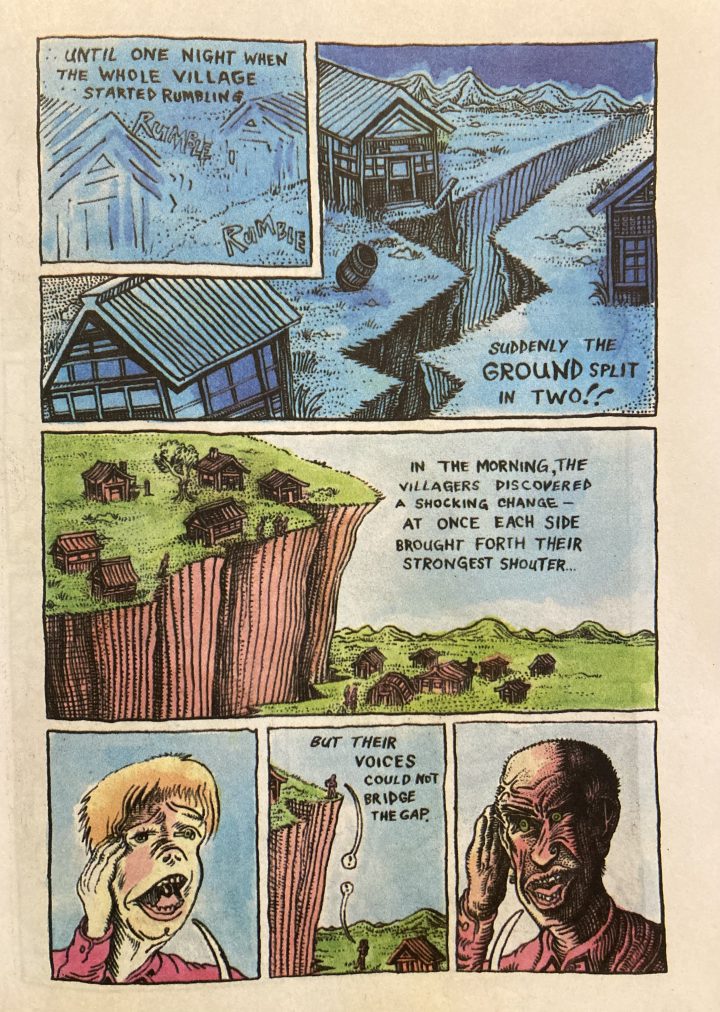
MVP: Max Burlingame, by a long shot. Evidently one of the only artists in this long anthology to understand its own assignment, Burlingame stuns with a beginning-middle-end 4-page fable called “The Great Rumbling.” The ideas therein are simple and effective: A peaceful village is divided when an earthquake creates a deep schism, splitting and separating everyone. When presented with an opportunity like this, a citizen without morals (“the carrot thief”) fills a power vacuum and becomes a venal despot. The people work together to reunite, leaving the self-appointed king alone atop the mountain for the rest of his life. The greens Burlingame uses for the grasslands and the blues he uses for the depth of night are alluring. Unlike many other Dino Funnies contributions , “Rumbling” has a clarity in line, storytelling, and intent. Burlingame also draws faces that are just off-putting enough to make them instantly intriguing. My only criticism of the tale is that happily ever after comes too soon. This could be an entire comic on its own and I hope that’s something Burlingame pursues in the future.
BIGGEST SURPRISE: When it comes to making comics for kids, of course there’s something to be said about not talking down and respecting the readership for where it’s at right now — opening the door for the weird kids, the artistic kids, the searching kids and introducing them to something that may have a mighty affect. But then there’s leaving kids in the dust of your alt-comics disorientation. I read this anthology twice with my boys (age 4 and 7) and right off the bat, they loved the Looney Tunes zaniness of Alyssa Appleberry and especially the Tana Oshima story about a teddy bear picking its nose. Everything else was deemed “sus,” and I don’t blame them. I was let down by previous column favorites Ashton Carless — his piece seems overly abstruse no matter what age you’re reading it — and Owwi Lee, whose spindly narrative abstractions had the four-year-old comment, “I think this is a comic for alien babies.” The seven-year-old got bored and said, “Can we just read the teddy bear booger one again?”
BOTTOM LINE: The ripples of Nickelodeon Magazine — Measles, even — are officially no longer being felt in the alternative comics community at large and it’s a real shame. Dino Funnies does not restore the feeling. If anthologies choose to go the theme route, some artists can meet the challenge (rarely do they transcend the theme), but most succumb to the completely unnecessary restrictions. I hope editors learn from all these half-baked outcomes. But I’m sure a half dozen more themed anthologies will sprout up, calling for submissions or crowd-funding money, before next month.

The Furnace and Other Stories, edited by Nelson Vicens
Speaking of crowd-funding, here’s a recent Kickstarter success. Put together by filmmaker and writer Nelson Vicens and a number of cartoonists that are either from Philadelphia or South America, seemingly cold-called over Reddit. It has a sheen of professional slickness and if you told me that the author has only ever read a handful of Image comics, I’d believe it.
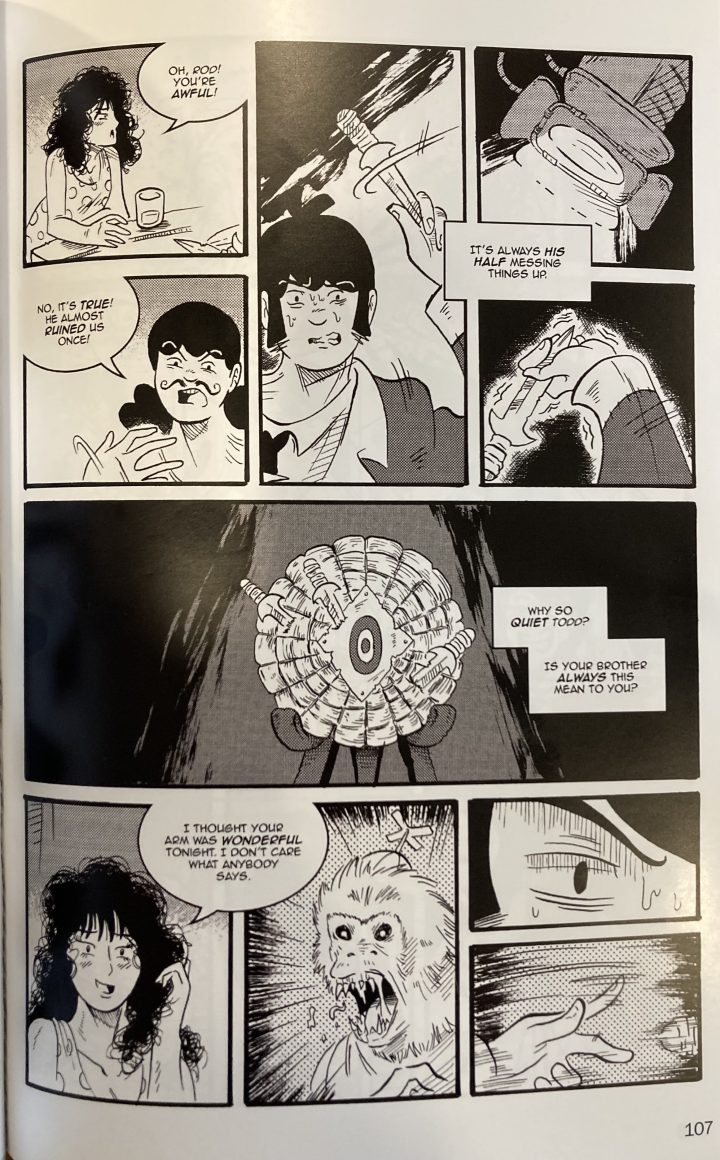
MVP: The book contains many different genres, ranging from cowboy horror, slice of life, science fiction, and parody advertisements. They all feature gaudy digital coloring. All except one, which remains black and white, and, coincidently or not, is the best contribution to The Furnace. It’s called “Caged” and the art is by Devan Muse. An old-timey circus features an act of conjoined twin knife throwers. The twins, connected at the neck, feature one who’s a mustachioed hot shot and another who’s more reserved and wary of all the attention they’re receiving. A fetishistic element comes into play when a pretty audience member sneaks backstage after the performance and the tension ratchets up, punctuated by a screeching monkey. Muse’s art is clear and the small panels snowball the momentum, creating an unease while also masking some of his amateurishness.
BIGGEST SURPRISE: No other contributors warrant much mention. But I’ll do it anyway. Box Brown is definitely the most recognizable and capable of all 17 artists, but Vicens literally gives him nothing to work with but a paper-thin dissertation on the loneliness of a parking violation monitor. I was excited to read the main cover story, written again by Vicens and drawn by Pat Aulisio, hoping it would provide some context to the viral and perplexing letter from a few years back. I was left hoping. Vicens tries to cynically comment on sex, love, and the seedier side of urban life, but does so without any bite. (I’d recommend Vicens and Aulisio look no further than Matt Seneca’s recent output for a more exceptional take on what they’re going for here.) The Furnace never finds any kind of inspired sequential flow, overly relying on sound effects and caption boxes. Vicens values his words over all else and lets them do the pacing and that leads to an all-encompassing feeling of emptiness.
BOTTOM LINE: This is a collection of 12 stories that don’t really say anything, just serve as exercises in creative writing. Furnace is less of a true collaboration and more of a boutique ego trip.

Bernadette #2, edited by Katie Lane and Angela Fanche
Breathe in. Breathe out. Bernadette is back. They brought along a lot of your favorite cartoonists (ugh, and poets and essayists. OK, that’s off my chest) from the first issue and added some serious major leaguers to the roster. Art is not a competition. Life is not a competition. But it’s interesting to see a few of the same artists here that also appear in Dino Funnies. Guess which stories are bettttter? The light in me honors the light in you.
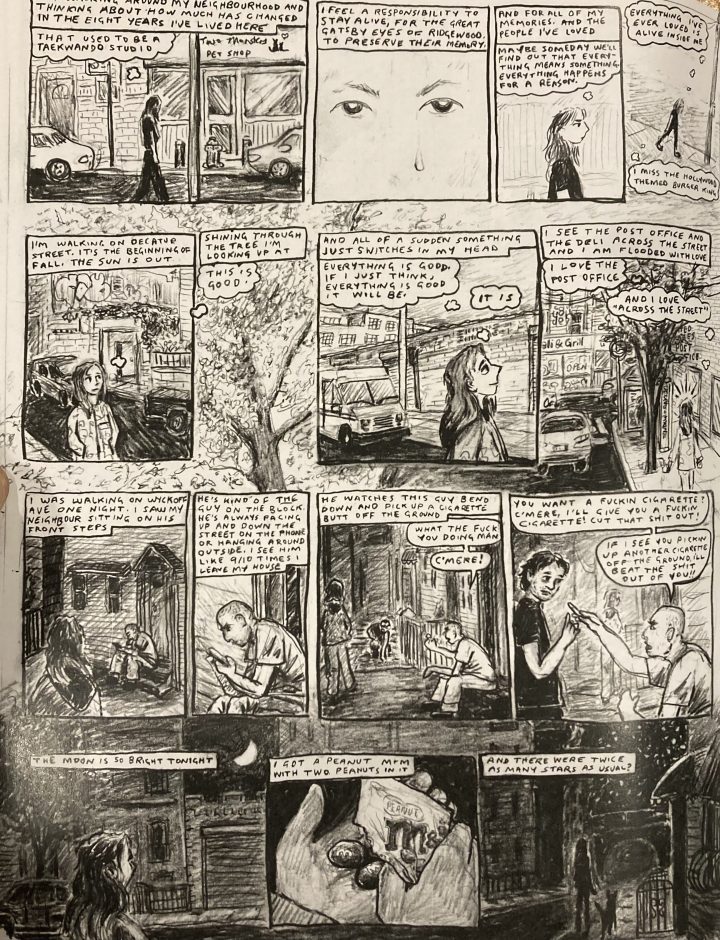
MVP: Allee Errico made me tear up. When I first read and reviewed her comics in January 2024, I thought they were better-than-average autobio fare made by a confident cartoonist. Errico still draws stories that are true to life, but they are less “Here’s a wild thing that happened to me and my dog best friend,” and much more about existing in a place of absolute introspection and excellence. The four pages here in Bernadette is one of the best and most emotionally impacting comics I’ve read all year long. With smudgy pencils, Errico binds Tiny Tim (my mom was on an airplane with him once!), Pompeii, and local laundromat signage. She finds herself in Heaven — “Catholic Heaven,” to be exact — and then back to Earth, grounded and grounding the reader in a specific New York cross street. The story is deeply personal while also being universal and will hit different depending on what day, even what time, you read it. The autobio genre doesn’t get better than this.
BIGGEST SURPRISE: The second volume of Bernadette is ultimately an anthology about connections. There are artists connecting with other bodies like in the leadoff story by Pio Drummond and Gina Wynbrandt’s attempt to get over an ex-boyfriend. There are comics about connecting with the people in your proximity. Ellen Addison bizarrely returns to in-person work and Clair Gunther (when are we getting a full comic from this artist?) finds a little park drama while walking a muscle-bound hound. Cartoonists Lydia Mamalis and Em Frank focus on verbal connections. A few take it a step further, with Mara Ramirez and Phoebe Mol making comics about the strings and webs holding everything together. I know that the editors didn’t push a theme, but a tethered wavelength was certainly achieved.
BOTTOM LINE: You know this "loneliness epidemic” we keep hearing all about? Bernadette is the cure!
That concludes 2025’s anthology round-up. Who else is ready to storm the Fantagraphics Offices like January 6th to demand another issue of NOW?
Questions, love letters, and submission to this column can be directed to @rjcaseywrites on Instagram.
The post Arrivals and Departures — November 2025 appeared first on The Comics Journal.

No comments:
Post a Comment